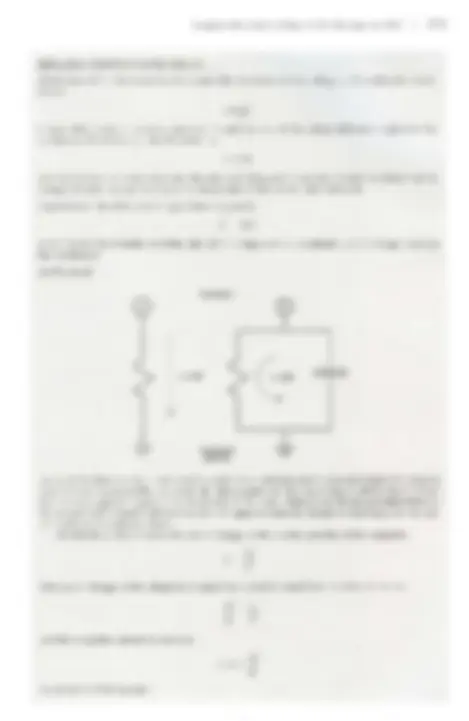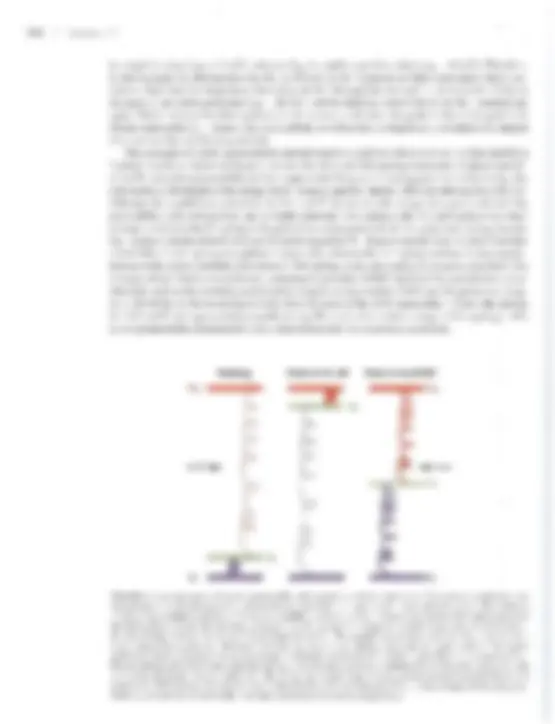











Study with the several resources on Docsity

Earn points by helping other students or get them with a premium plan


Prepare for your exams
Study with the several resources on Docsity

Earn points to download
Earn points by helping other students or get them with a premium plan
Community
Ask the community for help and clear up your study doubts
Discover the best universities in your country according to Docsity users
Free resources
Download our free guides on studying techniques, anxiety management strategies, and thesis advice from Docsity tutors
An in-depth exploration of the electrophysiology of synaptic transmission, focusing on membrane potentials, ion channels, and the role of calcium ions in exocytosis and neurotransmitter release. the basics of membrane potentials, the use of various techniques to study neuronal processes, and the importance of ion permeability and driving force in determining membrane potential impacts. It also discusses the controversy surrounding quantal release and the identification of key proteins involved in synaptic transmission and vesicle recycling.
Typology: Lecture notes
1 / 17

This page cannot be seen from the preview
Don't miss anything!










IDepartment of Zoology, University of Oklahoma, Norman, Oklahoma 73019; 'Departm ent of Biology, University of Toronto at Mississauga, Mississauga, Ontario LSL 1C6, Canada
ABSTRACT
Chemical synaptic transmission is an import a11t means of neuronal communication in the nerv- ous system. On the arrival of an action potenti al, the nerve terminal experiences an influx of cal- cium ions, which in turn trigger the exocytosis of synaptic vesicles (SVs) and the release of neuro- transmitters into the synaptic cleft. Transmitters elicit synaptic responses in the postsynaptic cell by binding to and activating specific receptors. This is followed by the recycling of SVs at pre- synaptic terminals. The Drosophila larval neuro- muscular junction (NMJ) shares many structural and functional similarities to synapses in other animals, including humans. These include the basic feature of synaptic transmission, as well as the molecular mechanisms regulating the synap- tic vesicle cycle. Because of its large size, easy accessibility, and the well-characterized genetics, the fly NMJ remains an excellent model system for dissecting the cellular and molecular mecha- nisms of synaptic transmission. In this chapter, we describe the theory and practice of electro- physiology as applied to the Drosophila lar val
Int rodu ct ion, 172 Box 1. Electrical Terminolo gy, 172 Box 2. Basic Equations and RC Circu it s, 173 The Rest ing Membrane Potential, 175 Synaptic Transmission, 181 Using Drosophila Larval NMj to Study Synaptic Transmission, 183 Protocol 1: Electroph ys i olog ical Reco rding from a " Mod el" Cell, 188 Protocol 2: Recording from Dro so phil a Larval Body Wall Muscles: Passive M e mbr ane Properties and Basic Features of Synaptic Transmission, 19 3 Protocol 3: Voltage-Clamp Analysis of Synaptic Transmission at the Drosophila Larval NM j , 200 Box 3. A Few Words of Caution Concerni ng Voltage-Clamp Experim e nt s, 201 Proto co l 4: Focal Recording of Synaptic Currents from Si ngle Boutons at the Larval NMj, 204 Protocol 5: Fabrication of Microel ectrod es, Suction Electrodes, and Focal Ele c trod es, 206 Rec ip e, 210 A ck nowledgments, 210 Ref erences, 211 WWW Resources: Suppliers of M ajor Electrophysiology Equipm e nt , 213
NMJ preparation. First, the basics of membrane potentials are introduced, with an emphasis on the rest- ing potential and synaptic potential. Second, the equipment and methods required to set up an electro- physiology rig are presented. Third, protocols are provided that explain how to u se the rig to record from muscles, determine the passive membrane properties of the muscle (i.e., input resistance and time con- stant), record synaptic potentials both intracellularly and extracellularly, detect synaptic currents by two- electrode voltage clamp, perform quantal analysis, and study short-term synaptic plasticity.
1 72 / Chapter 12
INTRODUCTION
Neurons use el ectrical a nd chemical signals to receive, process, and communic ate information. The basic currenc y of signaling by excitable cells (n e ur ons and muscles ) is electrical curr ent. Accordingly, electrophysiology is th e study of the electrical pr operties of cells, and we dr aw on the theoretical background of electrical phenomenon to help und ersta nd the behavior of th e ner vous system. By analogy, the cell m e mb ra n e is similar to a simpl e resis tor-capacitor (RC) circuit (see Boxes 1 and 2). In an electro ni c circuit, a batter y (voltage sour ce) is co nnected via conduc to rs (w ires) to a resistor a nd a capacitor a rr anged in parallel, with a ret urn wire to the batt ery that co mpl etes the circuit. Relatively s impl e ph ysical relationships de scribe th e fl ow of electrons thr ough th e wires. The cellu- lar equivalents to an elec tronic circuit are th e r es tin g m e mbrane potential (see below), which acts as the batter y; th e ext racellular and intracellular fluids, w hich act as th e low-resista nc e conductors ; ion channels w ithin ce ll m embr anes, which a ct as the resis tor s; and the pho s pholipid bilayer, which acts as a capacitor. An important difference be tw een ele ct ronic and cellular circuits is that electrons are the charged particles th at flow through an elect ro nic circuit, whereas in a biological circuit a variety of cations a nd ani ons (e.g., Na +, K+, Ca 2 +, Cl-) gene ra te membrane curr ents. Drosophila h as been used to great advant age as a m odel system for elucida tin g the molecular and genetic mech a ni sm s th at underlie bioelectric a nd bi ochemic al signaling. Th e in tro duction of the lar- val NMJ as an experim en ta l preparation es tablished a system th at permit s relativel y easy access to lar ge, electrica ll y excitable ce ll s (Jan and Jan 1976a,b ). Oth er electrical techniqu es applied to Drosophil a include el e ctror etinograms ( Hotta and Ben ze r 196 9; see Chapter 14), ex tr acellular recording from the
Box 1. ELE CT RI CAL TERMINOLOGY Charge (Q) : El ec tri c charge is a fund ame nta l pr ope lty of subatomic pa rti cles. By con ve ntio n an elec-
re pe l eac h oth er, a nd pa rti cles w ith opp os it e charges attract each othe r. The uni t of charge is kn own as th e co ul omb (C) and 1 C is equal to 6.25 x 10 18 cha rg es. In biological ce ll s, the charge is c arri ed by ions such as Na +, K+, Ca 2+, and CI -. Current (I): Th e d irec ti o nal movement of charge d pa rti cles is electri c c urr e nt, such as electron s mov - ing throu gh a metal co ndu ctor. Current is meas ur ed in amperes (A); 1 A is th e movement of 1 C of charge pe r seco nd. Voltage (V): Al so kn own as electrical pote nti al or pote ntial difference, voltage refe rs to th e difference in electric pote nti al betw ee n two points within an e lec tric field , such as a c ir cuit. By definit~ on , potential diffe re nce is the amount of wor k required to move a unit of cha rge. A 1-V pote nt ial diff e r- ence requires 1 J of work to se parate 1 C of chal"ge. Conductan ce (g! or Resistance (R or Q) : Th e fl ow of curre nt betwee n two po ints is ca ll e d condu c- tance; th e greate r th e conductance, th e easier it is for curre nt to fl ow. Resistance is th e in verse of conductance; the greate r the re sistance, th e ha rd er it is fo r curre nt to flo w. Condu ctance is meas ur ed in siemens (S) a nd resistance is meas ur ed in o hm s (Q ). Th e biological equ iva lent of conductance is the pe rm ea bility of ion cha nn e ls. Th e hi gher the co ndu ctance of a me mbrane, th e greate r th e num- ber of op en ion cha nn e ls. Capacitan ce (C): If two co nducting mate ri als are se parated by anin su lating layer, a capacitor is formed. Thi s co uld be two metal plates se parated by a nonconducting mate ri al; in th e ce ll , the lipid bilayer of th e membrane separates the conducting intrace llul ar and ex trace llul ar fluids. If there is an excess of p os itive charge on on e of th e condu ctors and a n excess of negative charge on the other, a potential difference deve lops betw ee n th e two co nductors. Capacitance is measured in farads (F): A
1 74 / Chapter 12
Box 2. (CONTINUED) Therefore, to determine the total amount of CUITent fl ow ing in c ir cuit (2), we can add the current through the resistor and the capacitor:
av V
at R
From this re lationship we ca n see that if the vo lt age is constant, th e n 'c = 0; when the vo~tage changes, ca pacitance is important. How does capacita nce affect th e behavior of a circuit? This can be seen eas il y by measuring volt- age diffe re n ces acro ss the two terminal s in the above c ir cuits when th e vo lt age changes:
v, Circuit 1
Time (msec)
Ini tia ll y, we will start with an arbitrary vo ltage (Va) at tim e O. If the voltage is instantly changed, we w ill see for c ir cu it (1) that the voltage we 'measure a lso changes in sta ntly, go in g in a downward direc- tion. H oweve r, for circuit (2) we see that the change is not in stant but rather takes so me period of time to settle down to the n ew le ve l. Thi s is the prope rty the cap ac it a nce adds- it s lo ws down th e response of the circuit to changes in vo lt age. Th e lo e lationship b etwee n voltage a nd time in an RC circuit is given by
in w hi ch t is time, R is the resistanc e, a nd C is the ca pac it an ce of the c ir cuit. Th e co mponent of th e equation RC is also kn ow n as the time constant or tau ('t: ) and this is a n important para meter for neu-
Fun ct ionally, th e me mbrane tim e co nstant refl ects how fast a ne uron or muscle responds to a synaptic signal. For a given ce ll , membr a ne capacitance (C) doe s not change, and the refore mem- brane resistance dete rmin es the time constant. Th e more channels open (low R), the faster th e re spon se b eco mes.
giant fiber pa thway (Tanouye and Wyman 1980; see C hapter 13), and the use of dissociated cell cul- tures (Wu et al. 1983 ) to gain access to th e relatively s mall neurons. More recently, in situ electrical recordings from the central nervous system of the embryo, larvae, and a dults (Baines and Bate 1998;
physiology techniques (Ka runanithi et al. 1997; Macleod et al. 2002; Marek and D avis 2002; Wang et
Synaptic Electrophysiology of the Drosophila NMJ / 175
al. 2004; Lima and Miesenbock 2005; Rasse et al. 2005; see Chapters 19-21), have expanded the reper- toire of techniques available to challenge and measure physiological processes used by neurons.
The physical basis of electrical signaling in cells is the resting membrane potential. Simply stated, there is a charge difference across cell membranes because the inside of a cell is electrically negat ive when compared with the outside. Understanding the origins of this electrical pot ential is the foun- dation for learning how changes in the membrane potential constitute signaling. How do we know that cells have a resting membrane potential? Julius Bernstein in 1902 was among the first to predict that a cell would have a negative resting potential. Direct evidence of cell resting potentials, however, was not available until electrophysiologists measured it in squid giant axons in the 1940s (Hodgkin and Huxley 1945; Hodgkin and Katz 1949). Today, using well -h oned techniques, it is relatively straightforward to gain electrical access to the inside of most cells. Glass micropipettes, having a tip diameter on the order of several hundred nanometers (for typical intra- cellular recording pipettes) are carefully inserted th rough the plasma membrane and into the cell lumen. Using the appropriate electronic hqrdware connected to the micropipette, cell resting poten- tials can be accurately measured and are typically -50-8 0 mY less than the outside.
How Is the Membrane Potential Generated? Two basic factors determine a cell's resting potential: unequal distribution of ions between the inside and outside of a cell and the selective permeability of cell membranes.
The ionic composition of th e ex tracellular fluid is different from that in the intracellular fluid. The extracellular fluid usually contains Na+ as the major cation, which is electrically balanced by a com- bination of CI- and HC0 3 - ions to maintain electrical neutrality. Smaller contributions to the extra- cellular charge come from K+, Ca 2 +, and Mg ++ , which again are balanced by Cl- and HC0 3 - ions. The major cation of the intracellular fluid is K+, with a smaller contribution from Na+. Intracellular free [Ca 2 +] is usually near 0, because Ca 2 + are bound to buffers, pumped into intracel- lular stores, or pumped out of the cell. Intracellular fluid has a greater abundance (compared with the outside of the cell) of large impermeable anions, chiefly proteins, DNA, and RNA. These nega- tive charges are balanced by intracellular K+, and it is for this reason that there is an imbalance of K+ across the cell membrane.
Selective Membrane Permeability The cell membrane is a phospholipid bilayer with associated peripheral and transmembrane pro-
and steroid compounds. Charged ions such as K+ an d Na+ do not readily cross the bilayer. They move in and out of the cell with the aid of transmembrane protein channels and transporters. Among these proteins is a family of ion channels, known as leakage channels, that primarily trans- port K+ (Goldstein et al. 1996), making the cell membran e relatively permeable to pot assium. The membrane, however, remains relatively impermeable to other ions when it is in the resting state.
The Physical Basis for Membrane Potential We see now that the resting membrane pot ential is a function of the ionic composition of the intra- cellular a nd extracellular milieus, th e charge difference that results, and the selective movement of ions across the membrane with the assistance of ion-selective protein channels and transporters. To
Synapti c El ectrophysiology of the Dro sophil a NMJ / 177
Biological systems develop a similar separation of charge across the plasma membrane and this is what we measure as the membrane potential. The K+ leakage channels are the major contributor to the resting permeability of the plasma membrane, but the ionic and cellular environment within and around a cell is obviously more complicated than the above illustration. Many more species of ions are involved, and, importantly, the plasma membrane is permeable to K+ and at smaller per- meability values to other ions as well.
Equilibrium Potentials of Individual Ions
The simplified experiment in the previous section illustrates that having unequal concentrations of ions across a semipermeable membrane gives rise to an electrical force. If the concentrations of ions are known, then the electrical force that is required to balance the force of the concentration gradi- ent can be predicted using the Nernst equation: E. = RT In [ion outside cell] IOn zF [ion inside cell] ,
in which Eion is the equilibrium potential for the ion, R is the universal gas constant, T is absolute temperature, z is the valence of the ion, and F is Faraday's constant. This equation is often simplified for monovalent cations when the cell is at 20 0 e:
[IOn mSlde cell] Note the change from natural logarithm to logarithm base-lO. In our example above, if the 0.1 M KCl solution is considered to be inside the cell and the 0.01 M KCl solution to be outside the cell, then EK + = -58 m V. This relationship can be used to calculate the equilibrium potential for any ion. The reader will see that this value is independent of permeability. Cations that are at a higher con- centration inside the cell will have a negative equilibrium potential, whereas cations that are at a higher concentration outside the cell will have a positive equilibrium potential. For example, typi- cally [Na+]out sid e = 100 mM, whereas [Na+Ln sid e = 5 mM, so the equilibrium potential for sodium is E Na+ = +75 mV.
The Resting Potential for an Entire Cell
Cells are in the presence of many different ions, both inside and outside the cell. To understand the resting potential for an entire cell, we need to consider the concentrations of those ions and their rel- ative permeability. The major contributing cations are Na+ and K+, and Cl- is the major anion. The Goldman-Hodgkin-Katz (GHK) equation describes the relationship between the voltage of the cell membrane (Vn ,), the permeability (P), and the concentrations of ions as
V = RT In P K[K + t t + P Na [Na + lout + PCI [Cl - t. m zF PK[K + ln+PNa [Na + ln+PCI[Cl-L t
Note the reversal of terms for Cl-, which reflects the negative valence of the chloride ion. Once again converting to logarithm base-lO and assuming a temperature of 20°C, the relationship becomes
V-I PK [K + lout + PNa [Na+ lout + PCI [Cl - lin m - 58 og + [+ _. PK [K lin + PNa Na In + PCI [Cl lout
Much of the work to derive this relationship was performed on the squid axon, in which it was found that at rest the permeabilities of K+:Na+:Cl- are 1:0.03:0.1. That is, in the resting squid axon, the permeability of K+ is 10 times greater than that of Cl- and 33.3 times greater than that of Na+. If [K +]out = 10 mM, [K +Ln = 400 mM, [Na+]out = 460 mM, [Na+Ln = 50 mM, [Cl- lout = 540 mM, [Cl- Ln = 40 mM, then
1 78 / Chapt e r 12
v = 5810 1(10)+0.03(460)+0.1(40) m g 1( 400) + 0.03(50) + 0.1(540)
=-70 mY.
Comparing the simplified version of the GHK equation with that of the Nernst equation, one sees that the resting membrane pot ential of the cell will always be close to the equilibrium potential of the most permeable ion. In this example, because K+ is the most permeable ion, V m approaches EK + with smaller contributions from the other ions.
The Na+/ K+ ATPase When the cell membrane is selectively permeable to a single ion (e.g., K+), passive diffusion of K+ down its chemical gradient first generates a negative potential inside. This electrical gradient works in favor of keeping K+ inside and will eventually become strong enough to completely stop the net efflux of K+. To reach this equilibrium state, very few ions are required near the membrane to main- tain a separation of charges compared with the number of ions that are present in solution, such that the [K +] on both sides of the membrane remains unaltered. At equilib rium , the net flow of K+ is 0 and no energy is required to maintain equilibrium. If, on the other hand, the cell is permeable only to Na+, then the equili brium potential will be completely different. Unlike K+, which sets the mem- brane potential to EK + (~ -90 m V), Na+ will bring the membrane potential to its own equilibrium potential, ENa+, which is typically more depolarized (~+50 to +75 mY). A more complex and dynamic situation arises, however, when a cell membrane is permeable to more than one ion. In a cell whose membrane is predominantly permeable to K+, a slight influx ofN(f+ wi ll disturb the equilibrium state ofK +. This creates a severe problem for maintaining Na+ and K+ dis- tributions across the membrane. One can imagine that each Na + influx will lead to a K+ efflux, and this vicious tug of war is impossible to stop without introducing a "peacemaker." In biological cells, this peacemaker is the Na+/K + pump, which pumps Na+ out and K+ in, such that [Na+] and [K+] do not change over time. There is a price, however, for maintaining the ion concentrations because the Na+/K + pump has to accomplish its task by going against each ion's electrochemical gradient. A significant amount of cellular energy, in the form of adenosine triphosphate (ATP), is consumed in this process. The Na+/K + pump is also an ATPase. In most cells, it pumps in two K+ ions in exchange for thr ee Na + ions out, thereby also making a direct contribution to the generation of the resting potential.
Membrane Permeability and Ion Channels If you understand the fundamental principle that the membrane potential of the cell is primarily a function of ion permeability (because ion concentrations are relatively stable), then understanding neural signaling is made much easier. What controls ion permeability? The K+ leakage channel can be regarded as an unregulated K+ pore that allows K+ to flow in or out of the cell. However, there are also a host of ion channels that alter their permeabilities to allow ions to cross the cell membrane. There are two broad categories of such "regulated" ion channels, defined by what regulates their opening and closing: voltage-gated channels (see Chapter 17) and ligand-gated channels. As the name implies, it is the membrane voltage that controls the opening and closing of volt- age-gated channels. Most of these channels are closed at the resting membrane voltage (V m)' but they open up when Vm is depolarized (becomes more positive). These channels usually allow only one specific ion to cross through the channel. As such, there are voltage-gated Na+ channels, voltage- gated K+ channels, and voltage-gated Ca 2 + channels. Within each category there are a variety of channel types, which confer specific properties on the cells that express them. Ligand-gated channels open when a ligand binds to a receptor site on the channel protein. At the fly NMJ, these are neurotransmitter (glutamate) receptors (indeed the phrases ligand-gated channel and neurotransmitter receptors can be used interchangeably). Unlike voltage-gated channels, ligand-gated channels are often permeable to more than one ion. For example, Na+, K+, and Ca 2 + can pass through the larval NMJ glutama te receptor once it is opened by the transmitter glutamate (Jan and Jan 197 6a).
180 / Chapter 12
is a negative value (e.g., -70 mV), whereas E Na+ is usually a positive value (e.g., +50 mY). Therefore, in this example the driving force for Na+ is 120 mv' IfNa + channels are fully open under these con- ditions, then there is a large force that will push Na+ through the channel. In contrast, Na+ influx at the peak of an action potential (e.g., +48 mY) will be minimal even if all of the Na+ channels are open. This is because the driving force (2 mY) is very small when the peak of the action potentials closely approaches ENa +. Hence, ion permeability, as well as the driving force, determines the impact of an ion on the membrane potential. The concepts of relative permeability and driving force and their dynamics can be illustrated by a "spring" model, as shown in Figure 2. At rest, the thick and thin springs represent a high permeabil- ity for K+ and a low permeability for Na +, respectively. Because the resting potential is close to EK +, the driving force (the length of the spring) for K+ is much smaller (shorter) than the driving force for Na+. Although the equilib rium potentials for Na+ and K+ do not usually change for a given cell, both the permeability and driving force can be highly dynamic. For example, the Na+ spring becomes much stronger relative to the K+ spring at the peak of an action potential. At this point, the driving force for Na+ reaches a minimal level, whereas it is at its largest for K+. Readers should keep in mind that after a brief delay the K+ spring strengthens dramatically, whereas the Na+ spring weakens during repolar- ization of the action potential (not shown). This spring model also applies to synaptic potentials. The example shown here is an excitatory postsynaptic potential (EPSP) mediated by nonselective cation channels, such as the nicotinic acetylcholine receptor at mammalian NMJs and the glutamate recep- tor at fly NMJ s. At the reversal potential, when the peak of the EPSP approaches -10mV, the springs for Na+ and K+ are represented as equa ll y strong. Hence, it is the relative strength of the springs-that is, the permeability of permeable ions-that determines the membrane potential.
Resting Peak of An AP Peak of An EPSP ____,_ ENa_
-..,_...- Vm
OmV~ ~ OmV .,..... Vm_
_____ EK_
FIGURE 2. A spring model of relative permeability, driving force, and th eir dynami cs. This cartoon models th e rela- ti ve permeabilit y, the drivi ng for ce, and membrane potentials of a typical ce ll at thr ee different stat es. The thi ckne ss of the spring correlates positively with th e permeability of an ion ch annel, wh e reas th e length of the spring repr es ents the driv in g for ce. At rest, the dominant strength of the K+ spring (PK +) brin gs the membrane potential (Vm) to wa rd EK+. But the driving fo rce for Na + is much higher than that for K+ Th e equilibrium potent ials for Na+ (ENa +) and K+ (E (^) K+) rare ly change for a given ce ll. However, both th e permeability and driving force can be highly dynamic. During the peak of an action potential, th e spring strength and length reve r se for K+ and Na+ such that PNa + o ve rpowers PK+, thereby bringing the membrane potential near ENa +. In a sy naptic potential mediated by non se lecti ve cation channels such as the g lu tamate re ce ptor at the fly NMj, th e spring is usually equal ly strong at th e reversa l potentia l. Hen ce , the peak of the EP SP approac hes - 1 0 mV Th e fundam ental take-hom e m es sa ge is that it is the strength of the spring (i .e. , relative permeability) of permeabl e ions that determines the membrane potential.
Synapti c Ele ctrophysiology of the Dro sophil a NMJ / 181
Synaptic transmission is the process by which neurons secrete neurotransmitter molecules from the nerve terminal onto target cells. Synaptic physiology has been studied for a long time and remains a favorite topic among neuroscientists. Although a complete review of synaptic transmission is beyond the scope of this chapter, highlighting some of the achievements and contemporary advancements is worthwhile. Synaptic physiology began when Bernard Katz and his colleagues recorded the first synaptic response at the frog NMJ in the 1950s using an intracellular microelec- trode. Their important studies, summarized in an elegant book (Katz 1966), provided the essential elements for our understanding of synaptic transmission. Their major findings were as follows.
Indeed in subsequent years much of the effort in synaptic physiology has been to test, retest, extend, and expand on these early ideas. A recent study appears to challenge the basic tenet of Katz's quan- tal theory (Fredj and Burrone 2009). Nearly simultaneous with the development of Katz's data on synaptic physiology, the first glimpses of the nerve terminal ultrastructure were obtained with an electron microscope. These ini- tial views of the synapse revealed the presence of small clear vesicular structures in the nerve termi- nal. This observation naturally gave rise to the notion that Katz's quantal units were in fact the synaptic vesicles. This remained a controversial notion, however, until the important work of Heuser, Reese, and others, who showed a correspondence between quantal release as measured by electrophysiology and vesicular release as observed with the electron microscope (Heuser et al. 1979). In the late 1980s studies began to reveal the molecular nature of synaptic transmission. Synaptophysin, VAMP (vesicle-associated membrane protein)/synaptobrevin, and SNAP-25 (synap- tosomal-associated protein 25) were among the first synaptic proteins to be identified and charac- terized (Trimble et al. 1988; Oyler et al. 1989; Sudhof et al. 1989). This was followed by the identification of synaptotagmin (Perin et al. 1990), syntaxin (Bennett et al. 1992), and Rab3 (Fischer et al. 1990) in the early 1990s (also see reviews by Jahn and Sudhof 1994; Hay and Scheller 1997; Chen and Scheller 2001; Jahn et al. 2003). Research into the molecular nature of cellular processes was (of course) not limited to neuroscience, and studies on neural proteins soon became greatly influenced by molecular studies in related vesicle trafficking disciplines within the broader frame- work of cell biology. Particularly noteworthy was the identification of endocytic protein dynamin (Chen et al. 1991; van der Bliek and Meyerowitz 1991) following earlier discoveries of clathrin (Pearse 1976) and AP2 (Keen 1987), as well as seminal studies emerging from the vesicle trafficking field (see reviews by Cremona and De Camilli 1997; Brodsky et al. 2001; Conner and Schmid 2003). Most noteworthy are the studies that first identified N-ethylmaleimide-sensitive factor (NSF) and the other SNARE (soluble NSF attachment receptor) proteins and the realization that VAMP, syn- taxin, and SNAP-25 were members of large protein families involved in a host of vesicular transport processes throughout the cell (Sollner and Rothman 1994). It had long been known that tetanus toxin and the botulinum toxins have profound effects on synaptic transmission. The discovery that these toxins were proteases that specifically cleaved VAMP, syntaxin, and SNAP-25 led to studies using them as probes that helped explain synaptic processes at the molecular level (Jahn and Niemann 1994). In particular, identifying the target molecules of these toxins quickly assigned a function to these recently discovered synaptic molecules.
Synaptic Electrophysiology of the Drosophila NMJ / 183
A Brief History of Neurogenetic and Electrophysiological Studies of Synaptic Transmission
Neurogenetic studies in Drosophila began with the premise that mutations of single molecules would alter the function of the nervous system, which would cause detectable changes in the behaviors of flies (Benzer 1973). With advances in molecular cloning techniques, it became possible to identify the genes whose mutations affected neural function. Touchstone publications include the report of temperature-sensitive alleles of shibire, which cause paralysis by blocking endocytosis of synaptic vesicles. It was discovered that shibire encodes the dynamin protein (Poodry and Edgar 1979; Koenig and Ikeda 1989; van der Bliek and Meyerowitz 1991). A temperature-sensitive allele of another Drosophila gene, comatose, also causes temperature-dependent paralysis. comatose encodes NSF (Ordway et al. 1994; Pallanck et al. 1995). Following these early studies, a number of other mutations affecting synaptic transmission have been discovered using forward genetics (e.g., stoned, Stimson et al. 1998; Fergestad et al. 1999; awd, Krishnan et al. 2001). Using reverse genetics, researchers within the Drosophila community began looking for fly homologs of the proteins being characterized in other systems. The general strategy was to perform searches, such as screening cDNA libraries, to identify the genetic regions that encode known synap- tic proteins, and then to make new mutants of these genes to study their effects on synaptic func- tion. In this way synaptotagmin, syntaxin, SNAP-25, VAMP/synaptobrevin, and complexin, among others, have been analyzed in Drosophila (DiAntonio et al. 1993; Littleton et al. 1993; Broadie et al. 1994; Schulze et al. 1995; Deitcher et al. 1998; Rao et al. 2001; Huntwork and Littleton 2007). Using reverse genetics, a number of endocytotic mutants (such as AP2, AP180, and endophilin) have also been generated and studied to understand their roles in synaptic vesicle recycling (Gonzalez-Gaitan and Jackle 199 7; Zhang et al. 1998; Verstreken et al. 2002). The creation of transgenics has also been a valuable method in understanding synaptic tr ans- mission in Drosophila (Spradling and Rubin 1982; Brand and Perrimon 1993). These studies include expression of genes bearing engineered site-directed mutants, expression of exogenous tetanus toxin, gene replacement strategies, acute inactivation of synaptic proteins, and tissue-specific a nd temporally controlled gene expression (e.g., Sweeney et al. 1995; Osterwalder et al. 2001; Roman et al. 2001; Marek and Davis 2002; Venken and Bellen 2007; also see Chapters 22 and 23). A notewor- thy example is research into the Ca 2 +-binding properties of synaptotagmin I (Syt I) (Mackler et al. 2002; Robinson et al. 2002). Syt I was found to have two Ca 2 +-binding C2 domains that interact with phospholipid and SNAREs, suggesting that it triggers tr ansmitter release (Perin et al. 1990). Direct testing of Syt I's ability to perform this function was only achieved by constructing site-directed mutants that alter the Ca 2 +-coordinating amino acids and introducing the transgene into syt I-null flies (Mackler et al. 2002; Robinson et al. 2002). These studies underscore the importance of com- bining molecular genetics with electrophysiology in understanding synaptic transmission.
USING DROSOPHILA LARVAL NMJ TO STUDY SYNAPTIC TRANSMISSION ..--~------------~~--- The fly larval body wall muscles are ideal for studying synaptic transmission. They do not express voltage-gated Na+ channels (Hong and Ganetzky 1994) and thus do not produce rapid action poten- tials. Neither do they exhibit Ca 2 +-dependent regenerate potentials unless the tracheal system remains intact and is perfused with air (Yamaoka and Ikeda 1988). Hence, all recordings from the body wall muscle are passive membrane properties or pure synaptic responses. Furthermore, the muscle is isopotential, making it possible to record synaptic potentials anywhere in the muscle (in contrast to the frog NMJ in which minis [spontaneous miniature synaptic potentials] can only be detected when the electrode is inserted near the synapse). For these reasons the fly larval NMJ prepa- ration h as become the gold standard in the Drosophila neurobiology field ever since it was first devel- oped for electrophysiological studies (Jan and Jan 1976a,b ). The key to understanding the electrophysiology of synaptic transmission lies in understanding the concepts of equilibrium potentials, driving force, selective permeabilit y, and the dynamic inter-
play of different channels open at a specific time. The intracellular recording technique detailed in the following protocols is relatively simple, yet powerful, allowing one to address all of the basic questions concerning passive membrane properties and synaptic transmission. The technique also lays the foundation for more advanced techniques, such as voltage clamp and patch clamp. All of these experimental methods are based on similar biophysical principles and have methodological and operational features in common. Hence, we highly recomme nd that the reader first master the skills of intracellular recording (Protocols 1 and 2) before moving on to the focal loose patch and the two-electrode voltage-clamp (TEVC) techniques (Protocols 3 and 4). In the CSHL course, students were provided with a number of "mystery" mutant strains so that they could use their newly acquired skills to characterize the mutant phenotypes and compare them with the wild-type larvae. These mutants included Sy~- 69 , snap-2S ts, lap, Kir mutant, and eag, Sh dou- ble mutants. 5y0- 69 and snap-2S ts^ mutants were chosen because they have higher rates of minis and produce larger EJPs compared with the wild type (Rao et al. 2001; Lagow et al. 2007). Once a student was more experienced, mutant flies were provided that had reduced synaptic transmission (such as syt , DiAntonio et al. 1993; Littleton et al. 1993; Mackler et al. 2002; lap, Zhang et al. 1998; Bao et al. 2005 ). The eag, Sh double mutant is unique because the motor axons are hyperexcitable, making it possible
studying the effect of leak potassium channels on resting potential and on passive membrane proper- ties (Paradis et al. 2001). A bonus of the Kir mutant is that it gives students the opportunity to appre- ciate the power of retrograde compensation in maintaining synaptic homeostasis (Paradis et al. 2001).
Electrophysiology Equipment The electrophysiology setup is commonly referred to as a rig. The rig used in the following proto- cols is based on equipment and software used in the Co ld Spring Harbor Laboratory (CSHL) course, Neurobiology of Drosophila. Manufacturers regularly upd ate their products and periodically replace old products with new models. Equipment from reputable commercial suppliers other than those mentioned here should work equally well. Hence, we strongly recommend that you contact the ven- dors and work with them closely before purchasing a piece of equipment for a rig. Contact infor- mation for the major suppliers of electrophysiology equipment may be found at the end of the chapter under the section WWW Resources. Here we describe briefly the components of an electro- physiology rig. Figure 4 shows exampl es of the major rig components using either an upright com- pound microscope (Fig. 4A-C) or a stereomicroscope (Fig. 4D). Vibration Isolation Table: The table is intended to reduce vibration and minimize mechanical dam- age to cells. Suggested suppliers are Newport Corporation and Technical Manufacturing Corporation. Microscope: A microscope is used to visualize the preparation and electrodes. Any stereomicroscope with a long working distance is sufficient for most of th e intracellular recording and TEVC experi - ments routinely conducted with fly larval NMJ preparations. Examples of stereomicroscopes include' the Leica M50, Nikon SMZ645, and Olympus SZX7. In fact, any dissection microscope will do the job, provided you can clearly visualize the body wall muscle. Some investigators prefer an upright compound microscope equipped with 5x and lOx air objectives and a 60x water-immersion objec- tive with long working distance (e .g., Olympus BX51WI with LUMPFL 60xW WD3.3 mm objec- tive). A compound microscope is mor e costly, but experiments can be conducted that are not possible with a stereomicroscope. For example, with a compound microscope, single-bouton record- ings can be made within the NMJ, the morphology of a single synaptic bouton can be explored, and optical imaging of the NMJ (using green fluorescent protein [GFP], red fluorescent protein [RFP ], or calcium indicators) can be performed at the l evel of a single synaptic bouton. Amplifier: It amplifies small synaptic or membrane electrical signals above noise levels so those physiological signals can be visualized and recorded. In the CSHL course, an AxoClamp2B or AxoPatch 200B (Mol ec ular Devices) amplifier was used. However, any good amplifier from a rep- utable supplier will work well. The amplifier should come with holders for micro electrode and head
186 / Chap ter 12
Stimulator: To excite an axon to fire action potentials, a brief electrical shock must be delivered to it. A stimulator and isolator are used to program the stimulation paradigms (such as stimulation fre- quency, duration, and strength). Suggested products are the S48 square pulse stimulator and SIUS isolator (Grass Technologies/Astro-Med, Inc.) or the Master-8 and ISO-Flex stimulus isolator (A.M.P.I., Israel). If you are only delivering simple pulses (such as a single stimulus or two pulses), a stimulator is not required. Instead, use the built-in software with the Clampex program as a "stim- ulator" (for safety reasons a stimulus isolator must be used). Micromanipulators: Micromanipulators help position the electrode(s) and assist in impaling the cell membrane with minimal physical damage. Larval NMJ recordings require one "coarse" manual manipulator (e.g., Narishige MM-3; Siskiyou MXllO), which is usually placed on the left side and is used to position the stimulating ("suction") electrode. Two "fine" manipulators are needed to help position the recording electrode and impale muscle fibers. A manipulator with fine movement can be manual (e.g., Narishige NMN-2S), hydraulic (e.g., Narishige MHW-3), or motorized (e.g., Sutter Instruments MP-22S or MP-28S; Burleigh PCS-SOOO). The fine manipulator is a critically important piece of equipment because it is used to direct the electrode to impale muscles and to hold the elec- trode in a stable position. It is prudent to obtain the best micromanipulator possible. Microelectrode puller: This device is used to pull the high-quality micro electrodes needed for impal- ing cell membranes. As one of the most important (but often overlooked) pieces of electrophysiol- ogy equipment, an electrode puller will determine how reliable your electrodes will be over time. Suggested products are the P-97 or P-lOOO Flaming/Brown Micropipette Puller (S utter Instruments) or the PC-l 0 Puller (Narishige). Other Items: BNC cables Glass capillaries for manufacturing microelectrodes Grounding wires and silver wires Light source MicroFil (World Precision Instruments) Syringe (l-mL), filled with 3 M KCI and to be used with MicroFil to backfill a micro electrode Video Monitor System: This is optional, but for teaching purposes it is extremely useful, because it allows up to five students to simultaneously visualize NMJ preparations and to watch their own actions (such as electrode position/movement) on a large monitor. Oscilloscope: This is optional, although an oscilloscope has mor e functions than does a computer. No two electrophysiology rigs are identical, because each laboratory configures theirs to suit-their needs. In addition, different experiments require minor modifications to the rig, such as varying the number of micromanipulators needed depending on the number of electrodes being used. Historically, the system for signal observation and data storage has gone through the most dramatic change (and improvement) within the last 20 years. Instead of the traditional oscilloscope, chart recorder, and magnetic tapes, electrophys iological data are now visualized, acquired, and stored in digital formats in a computer using specially designed software. Using Axoclamp 2B and the Digidata data acquisition systems as examples, a diagram of wiring connections for an electrophys iology rig that can be used for both intracellular recording and TEVC is provided in Figure S.
Synaptic Electrophysiology of the Drosophila NMJ / 187
Amplifier
)r
~
?
INPUTS
: Back^ panel^ (INPUT^ S) Fro nt pan el (O UTPUT S) OUTPUTS (^) 10Vm 0.1 X 12 V
STIMULATI ON StIso^ imu l l ator^ us^ Stimu la tor :
Computer a INTERFAC^ ADIDA
nd E Computer^
Start & pClamp USB
,..--------. (^) :
OutputsDigital^ OutputsAnalog^ AnalogInputs Digidata FIGURE 5. A wiri ng diagram for an electrophysiology rig. A rig can be divided into four major components based on the flow and processing of electrical signals: inputs, outputs, stimu lation , and interface and data acquisition. Once connected through a BNC cable as illustrated here, these components will become a functional electrophysiology rig. The w iring diagram shown here is based on the AxoCiamp 2B amplifier, Digidata, and pClamp software. However, this diagram can be used as a reference for any other similar products. Membrane potentials recorded by microelec- trodes are detected by specific probes and then sent into an amplifier through corresponding channels (such as ME and ME2J. Once amplified by the amplifier, the electrical signals travel to the AD interface board to be converted into digital forms and then acquired by the computer using specially designed softwar e. The interfa ce board is also capa- ble of producing signals to command either the stimu lator or the amplifier. A voltage or current delivered through the stimulus isolator and a suction electrode is used to stimu late the motor axons into firing action potentials. A st imul a- tor is used to program different stimu lu s parameters so that one can contro l the stimulus duration and frequency. The software and DA interface board can also be used to control the stimu lus pulse, but they do not have great flexibility for users if one wants to have more comp lex stimu lu s paradigms.